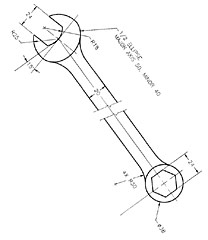Difference between revisions of "Nitrogen tire inflation"
(Created page with "Back to main mod page This is a sample picture <br> Filling your tires with Nitrogen is a service...") |
(No difference)
|
Latest revision as of 09:37, 9 July 2018
Filling your tires with Nitrogen is a service offered by some tire shops, repair facilities, and even car dealers. While typically it costs about $6 USD/tire, the service may be free or may be used to scam misinformed consumers out potentially hundreds of dollars. Alternatively, you can fill your tires with nitrogen yourself with the proper equipment. There is a good deal of argument about the benefits of Nitrogen filled tires in passenger vehicles.
Contents
Theory & Practice
Atmospheric air is comprised of about 78% Nitrogen already. Oxygen accounts for another 21%, and the other 1% largely of water vapor, CO2, and noble gases like Argon and Neon. That's right, your tires are filled mostly with Nitrogen already. But it's the other 22% of that atmospheric air where the benefit is to be had. The Nitrogen going into your tires is only about 93% pure, so truly you would only be affecting about 15% of the tires air.
Nitrogen is less likely to migrate through the rubber walls of the tire than is Oxygen and also reacts much less to changes in temperature. The result is less fluxuation in tire pressure over a greater distance and span of time, cooler tires, and decreased wear. It's heavily used in motor racing for these reasons and for the added benefit of allowing crews to fine tune tire pressure for the track's learning curve and variable conditions. The average passenger car driver will notice this in the car's slighlty improved handling, fuel economy, and in fewer trips to the tire store and the air compressor. Maintaining proper tire pressure is key for fuel economy, so perhaps it will mean fewertrips to the gas station, in the grand scheme of things.
In theory, replacing atmospheric air with nitrogen would also slightly lighten the wheel assemblies, huge contributors to unsprung weight on any vehicle, thereby decreasing rolling resistance and increasing aerodynamic and thus fuel efficiency. Granted, this is at the molecular level, which is largely immeasurable by the typical DIYer.
It may also help prevent wheel and tire rot by expelling corrosive water from the inside of the tire.
Instructions for mod
For anyone without access to bottled nitrogen gas or a nitrogen generator, they will need to take their vehicle and/or wheels to a shop that offers this service. To properly do this mod, the oxygen and moisture in the tires need to be purged. This cannot be accomplished with a single filling alone. The tires need to be filled with nitrogen and depressurized several times before being properly inflated in order to remove the water and atmospheric air content entirely. A shop typically accomplishes this with an automated machine attached to their air compressor that purges the compressed air of Oxygen and other elements before automatically inflating and deflating the tire several times.
User experiences
The following is a poorly conducted and unscientific single user test, the parameters of which are entirely undefined here, and the results of which should be taken with a grain of salt - which, oddly enough, is approximately the size of this individuals understanding of the scientific method.
| User Name | Car Make, Model, Year | Cost of Mod | Time to Perform Mod | MPG Before Mod | MPG After Mod | MPG improvement guess | Instruction Link |
|---|---|---|---|---|---|---|---|
| oil pan 4 | 1984 Chevy Suburban (displacement, tire & rim size?), 1985 Chevy Camaro (dtr?), 1999 Toyota Tacoma (dtr?) w/ a utility trailer | $0 wasted | 1 Hour | N/A | N/A | No improvements noted | User mod detail or measurement detailed data |
Why were no mileage figures given for before/after? If there was no change, you still provide figures for your baseline. How else can anyone be sure that there was no effect or that they have even tested and controlled for it? Under what conditions were those tests performed? Same day, same track? It is not science without data.
Problems / Consequences of mod
It is largely unnecessary as atmospheric air works fine for 99% of vehicle applications and the benefits of Nitrogen are marginal. Gains would likely be difficult to measure, and a proper ABA test would be impractical for the typical DIYer, if not outright expensive.
References
Forum thread links
External links
Best link on the internet for real tire info get nitrogen dot org [1]
